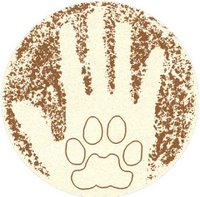 The tracks and sign of raccoon, deer, mouse, cat and lots of dog (Chagi-ya) encapsulated Earth Connect's (EC) first ever Tracks and Sign class.
The tracks and sign of raccoon, deer, mouse, cat and lots of dog (Chagi-ya) encapsulated Earth Connect's (EC) first ever Tracks and Sign class."So much information to cover and so little time" was our mantra. The students (nine) were eager to learn the basics and very much appreciated the macro to micro lesson plan along with hands-on activities. Practicing the gait patterns on our hands and knees really drove home the way animals move. The "wisdom marks" sandbox really demonstrated how some tracks can age because there was a rain that occurred a week ago that obscured a fourth of the marks. We even had some great examples of aging mud/gravel deer and racoon tracks under the water of a slow moving stream.
One tracks and sign story told of how mice climbed a Autumn Olive tree and chewed through many of the branches that were ladden with ripe fruit. We surmized that it was a combination of efficient use of energy by reducing the amount of climbing and to make it less dangerous to eat the fruit. Eating them on the ground instead of the tree keeps them safe from owls.


EC's next class is fall wild edibles on 14 October. Sign up soon so we can prepare the right amount of wild edible goodies.




